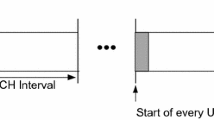Abstract
In infrastructure-less ad-hoc networks, the nodes can converse directly with other nodes without centralized servers. The vehicular networks are derived from the features of mobile ad-hoc networks (MANETs) whereas the message transmissions between the nodes are direct with each other or through some fixed terminals. But, a unique trademark is that the vehicle-to-vehicle ad-hoc links are poor because of extreme mobility which leads to frequent route breakage that causes emergency message delivery failure. The routing protocols availed in MANETS does not suit due to quick topology changes. The hop selection is based on the best cumulative communication duration that will be failing in some cases. Also, the worst/average case scenario is that the minimum connectivity to the source vehicle is not described in existing approaches. The core idea about the proposed research is to deliver data through an optimum path and to eliminate rupture link during the packet transmission. The system uses the Heterogeneous Motion Guess (HMG) algorithm for vehicular networks to set up a vested path. The HMG will select the relay vehicle's current position is near to the target vehicle plus the vehicle will opt the relay forwarder that has good radio coverage. The link lifetime of the selected hop should be greater than the minimum connectivity duration with the source vehicle. The selected vehicle will append the link expiry time and minimum connectivity duration in Route Demand Dispatch message in a unicast manner. This approach significantly minimizes the hop count numbers and improves the stability of the path. It radically predicts the link life, so the node can decide an alternative vested route. The simulation result shows how well the reactive demand-based HMG affords optimum results in terms of packet transmission success rate, average minimum hop counts, and communication delay.










Similar content being viewed by others
References
Biondi, F., Strayer, D. L., Rossi, R., Gastaldi, M., & Mulatti, C. (2017). Advanced driver assistance systems: Using multimodal redundant warnings to enhance road safety. Applied Ergonomics,58, 238–244. https://doi.org/10.1016/j.apergo.2016.06.016.
Karimi, R., & Shokrollahi, S. (2018). PGRP: Predictive geographic routing protocol for VANETs. Computer Networks,141, 67–81. https://doi.org/10.1016/j.comnet.2018.05.017.
Lin, D., Kang, J., Squicciarini, A., Wu, Y., Gurung, S., & Tonguz, O. (2017). MoZo: A moving zone based routing protocol using pure V2V communication in VANETs. IEEE Transactions on Mobile Computing.,15(5), 1357–1370. https://doi.org/10.1109/TMC.2016.2592915.
Atallah, R. F., Khabbaz, M. J., & Assi, C. M. (2015). Vehicular networking: A Survey on spectrum access technologies and persisting challenges. Vehicular Communications,2(3), 125–149. https://doi.org/10.1016/j.vehcom.2015.03.005.
Chaqfeh, M., & Lakas, A. (2016). A novel approach for scalable multi-hop data dissemination in vehicular ad hoc networks. Ad Hoc Networks,37, 228–239. https://doi.org/10.1016/j.adhoc.2015.08.021.
Karp, B., & Kung, H. T. (2000) GPSR: Greedy perimeter stateless routing for wireless networks. In Proceedings of the 6th annual international conference on mobile computing and networking (pp 243–254). New York: ACM. https://dx.doi.org/10.1145/345910.245953
Wang, C.-F., Chiou, Y.-P., & Liaw, G.-H. (2015). Nexthop selection mechanism for nodes with heterogeneous transmission range in VANETs. Computer Communications,55, 22–31. https://doi.org/10.1016/j.comcom.2014.09.001.
Yang, X., Li, M., Qian, Z., & Di, T. (2018). Improvement of GPSR protocol in vehicular ad hoc network. IEEE Access, Security and Privacy for Vehicular Networks.,6, 39515–39524. https://doi.org/10.1109/ACCESS.2018.2853112.
Nguyen, T. D. T., Le, T.-V., & Pham, H.-A. (2017). Novel store–carry–forward scheme for message dissemination in vehicular ad-hoc networks. ICT Express,3(4), 193–198. https://doi.org/10.1016/j.icte.2017.11.009.
Sivakumar, T., & Manoharan, R. (2016). SRP: A stable routing protocol for VANETs. International Journal of Applied Engineering Research.,11(5), 3499–3504.
Fogue, M., Martinez, F. J., Garrido, P., Fiore, M., Chiasserini, C.-F., Casetti, C., et al. (2015). Securing warning message dissemination in VANETs using cooperative neighbor position verification. IEEE Transactions on Vehicular Technology,64(6), 2538–2550. https://doi.org/10.1109/TVT.2014.2344633.
Fonseca, A., & Vazao, T. (2013). Applicability of position-based routing for VANET in highways and urban environment. Journal of Network and Computer Applications,36, 961–973. https://doi.org/10.1016/j.jnca.2012.03.009.
Huang, X., & Fang, Y. (2009). Performance study of node-disjoint multipath routing in vehicular ad hoc networks. IEEE Transactions on Vehicular Technology,58(4), 1942–1950. https://doi.org/10.1109/TVT.2008.2008094.
Namboodari, V., & Gao, L. (2007). Prediction-based routing for vehicular ad hoc networks. IEEE Transactions on Vehicular Technology,56(4), 2332–2345. https://doi.org/10.1109/TVT.2007.897656.
Menouar, H., Lenardi, M., & Filali, F. (2007). Movement Prediction-based routing (MOPR) concept for position based routing in vehicular networks. In IEEE 66th vehicular technology conference (pp 2101–2105). Doi: 10.1109/VETECF.2007.441
Lochert, C., Mauve, M., Fussler, H., & Hartenstein, H. (2005). Geographic routing in city scenarios. ACM SIGMOBILE Mobile Computing and Communications Review.,9(1), 69–72. https://doi.org/10.1145/1055959.1055970.
Lochert, C., Hartenstein, H., Fussler, T. J., Hermann, D., & Mauve, M. (2003). A routing strategy for vehicular ad-hoc networks in city environments. IEEE Proceedings of the Intelligent Vehicles Symposium,1, 156–161. https://doi.org/10.1109/IVS.2003.1212901.
Zidani, F., Semchedine, F., & Ayaida, M. (2018). Estimation of Neighbors Position privacy scheme with an Adaptive Beaconing approach for location privacy in VANETs. Computers and Electrical Engineering,71, 359–371. https://doi.org/10.1016/j.compeleceng.2018.07.040.
Author information
Authors and Affiliations
Corresponding author
Additional information
Publisher's Note
Springer Nature remains neutral with regard to jurisdictional claims in published maps and institutional affiliations.
Rights and permissions
About this article
Cite this article
Srithar, S., Saravanakumar, N.M. An Improved Heterogeneous Motion Prediction Algorithm for Vehicle-to-Vehicle Message Ferrying in VANETs. Wireless Pers Commun 113, 695–714 (2020). https://doi.org/10.1007/s11277-020-07248-8
Published:
Issue Date:
DOI: https://doi.org/10.1007/s11277-020-07248-8




